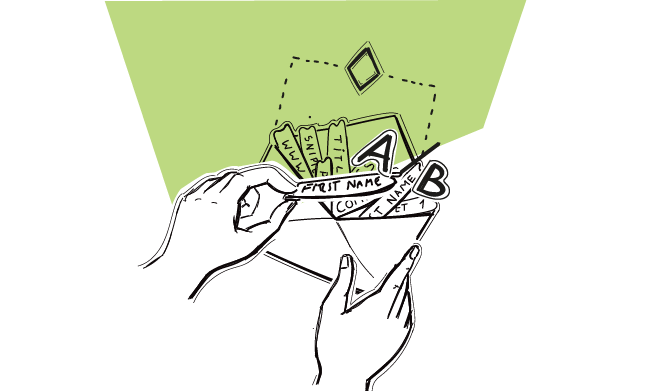Three questions: What’s the little big thing that makes our cold email interesting from the very first line? What makes our prospect feel that we really care about talking to them? What changes generic bulk emails into personal valuable messages? One answer: Personal touch. And note that putting in our addressee’s first name in the salutation is not enough nowadays. Here’s how to add a personal touch to a cold email campaign in 3 steps.
Step 1: Skillful research
That’s the most laborious step of all the three. I wouldn’t say I’m actually happy when I have to do that before launching my cold email campaigns. But I’m definitely happy when those personalized campaigns bring over 50% reply rates. That’s when I’m overjoyed. And that’s when I forget how much time I’ve spent searching for info on my prospects to add a personal touch to every email.
This step will be fun for those who always wanted to be detectives or those who deeply analyze all their friends’ (and the friends’ of their friends’) Facebook profiles. There are a few places that are mines of information about your prospective clients. Check the link below for the list of places and some practical details.HOW TO MAKE MY COLD EMAILS PERSONAL? VOL.1: RESEARCH >>
Step 2: A copy that includes personal touch email fragments
The research you do in step one is not only to find out who your prospects are. It’s also to find a common denominator for all the prospect group members. Think of what actually makes them a group. Then you can use the information from the common denominator place in your email copy.
In short: in the first step, you find and collect the information on your addressees. And in the second step you create a cold email template that is the same for all your prospects, but allows you to send an individually customized message for each of them. Sounds hardly possible? Check the link below to find a few ways to make that happen:HOW TO MAKE MY COLD EMAILS PERSONAL? VOL.2: COPY >>
Step 3: Savvy sending tools
So after taking the first two steps you’ve got an awesome template and a collection of personal touches that are to be incorporated into the template. It takes some precious time to prepare all that. So when it’s finally done, you don’t feel like spending another few hours each day of the upcoming week to copy and paste the info to each of your emails manually and send each of the messages one by one. That would be a real drag.
In the first two steps, you did the job that no automation tool is able to do for you: you created a human, highly personalized cold email campaign. You did a great job. In the third step you can hire a clever automation tool like Woodpecker to take care of the sending part for you. Here’s how to set such a cold email campaign on intelligent auto-sending mode within minutes:HOW TO MAKE MY COLD EMAILS PERSONAL? VOL. 3 TOOLS >>
What’s in it for you (to remember)?
The whole highly personalized approach to cold emails stems from the two guide principles that make your prospects appreciate your cold emails instead of hating them:
Rule #1: Create a personal message, because you’re sending it to a personal business mailbox, where personal messages usually come.
Rule #2: Sending that message, show your addressee that you actually DO give a damn about them, before you assume they will give a damn about you.
Follow the two rules each time you plan your email outreach, and you’ll see amazing results very soon.
Hope this helps!
Bonus: Common mistakes to avoid when adding a personal touch to cold emails
When writing personalized cold emails, some common mistakes can lower your response rates. It’s easy to think that just using the prospect’s name is enough, but basic personalization rarely stands out.
To truly connect, you need hyper-personalized cold emails that speak to your target audience’s pain points and needs.
Avoid using only basic personalization
One mistake is focusing too much on generic phrases. A personalized cold email should go beyond simple details like the company name. Instead, address something specific to your prospect’s situation. Mention mutual connections or recent achievements that show you’ve done your homework. This makes your cold email feel genuine and relevant.
Make the subject line personalized and engaging
Another issue is neglecting the subject line. Your subject line is the first thing your prospect sees, and it can make or break the open rate. Personalized subject lines catch attention quickly and spark curiosity. Using a cold emailing tool helps you tailor each subject line, making your message more engaging.
Keep your cold emails concise and focused
Avoid writing long-winded messages. Cold emails should be clear and concise. Jump straight to how you can solve their pain points. Overloading your cold email with too many details can push prospects away.
Customize your cold email templates for each target audience
Lastly, don’t use the same personalized cold email templates for every campaign. Each target audience requires a unique approach. Adjust your cold email personalization to reflect their specific needs. By focusing on these details, you can create personalized emails that resonate and drive results.
READ ALSO

These Are 6 Tips to Shape Outbound Sales in 2026
It’s almost time to say goodbye to 2018 and welcome 2019. The end of the year is fast approaching. 2018 has flown by and with year-end closing in, it’s time to start making plans for the future. Looking back at the passing year, we can definitely say that there’s been a lot going on; from a worldwide concern about personal data protection, through a data-driven approach to selling, to an all-bound lead generation and “smarketing”.

What Should I Learn About a Company Before Sending Them a B2B Sales Email?
This is a piece inspired by a very good question I've come across on Quora. It will be especially helpful to those of you who either prepare to start their first sales email copy, or they've been sending cold emails that don't bring the desired effects.

What Mail Merge Custom Fields Can I Use for Clever Outreach?
What are mail merge custom fields, dynamic fields, or snippets? However you call them, these are just the pieces of information about each of your prospects that can be merged into your email templates to make your messages catch people's attention. Oh, and one more thing - successful cold email outreach can't be done without them. In this post, I'm sharing some ideas for custom fields, other than the traditional first name and company name. Learn where to find them and how to add them to your prospect base for more effective personalization at scale.
